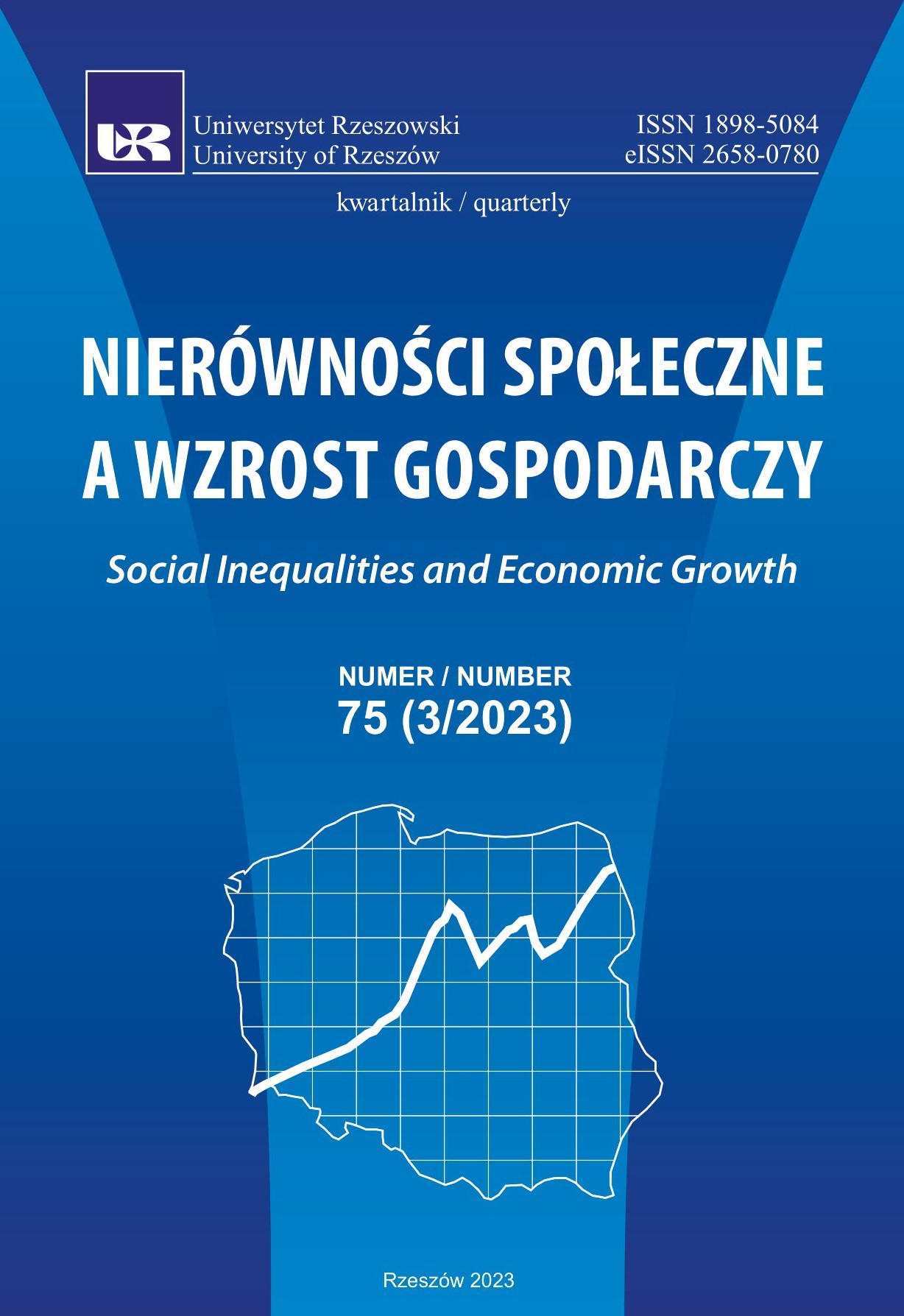Zmiany handlu zagranicznego Ukrainy jako odzwierciedlenie jej postępu w integracji z Unią Europejską
DOI:
https://doi.org/10.15584/nsawg.2023.3.10Słowa kluczowe:
handel zagraniczny Ukrainy, integracja Ukrainy z UE, konkurencyjność Ukrainy, specjalizacja handlowaAbstrakt
Celem pracy jest ocena zmian zdolności towarów ukraińskich do konkurowania na unijnym rynku. Odzwierciedla ona postęp Ukrainy w integracji z UE w okresie poprzedzającym napaść Rosji na Ukrainę. Wykorzystując mierniki handlu zagranicznego, w tym międzynarodowej specjalizacji, pokazujemy specyfikę integracji Ukrainy z UE. Szacując poziom oraz zmiany udziałów rynkowych grup towarowych Ukrainy na unijnym rynku, wskazujemy na jej postęp w penetracji tego rynku względem krajów nieunijnych. Z jednej strony, w latach 2010–2021 miały miejsce radykalne zmiany struktury geograficznej handlu zagranicznego Ukrainy. Z drugiej, mniejszym zmianom struktury towarowej eksportu i międzynarodowej specjalizacji Ukrainy, towarzyszył wzrost udziałów rynkowych eksportu Ukrainy na unijnym rynku. Odzwierciedlał on poprawę zdolności ukraińskich towarów do konkurowania, a więc spełnienia przez Ukrainę jednego z kryteriów akcesji. Obliczony, na podstawie udziałów rynkowych, wzrost zdolności do konkurowania ukraińskich towarów potwierdzają szacunki wskaźników konkurencyjności eksportu: ujawnionych przewag komparatywnych Balassa oraz Lafaya. Poziom i zmiany trzech wskaźników konkurencyjności były zróżnicowane między grupami towarowymi. Wzrostowi udziałów rynkowych trzech grup towarów: surowców, tzw. pozostałych wyrobów przemysłowych (o średnim i niskim poziomie technologii) i żywności towarzyszył znaczący i rosnący poziom wskaźników konkurencyjności eksportu. Spadkowi udziałów rynkowych pozostałych grup towarów towarzyszył niski i zmniejszający się poziom wskaźników specjalizacji eksportu. Tym samym dotychczasowa integracja Ukrainy z UE oparta jest na ekspansji towarów konkurencyjnych i zwiększających konkurencyjność, w produkcji których Ukraina się specjalizuje.
Downloads
Bibliografia
Artamonova, H. (2019). Ukraine’s foreign trade with EU: opportunities and challenges. Journal of European Economy, 18(3/70), 338–350. DOI: 10.35774/jee2019.03.338.
Babenko, V., Biletska, Y., Pelyak, H. (2019). Ukraine-EU: economic integration strategy. Geopolitics under Globalization, 3(1), 12–23. DOI: 10.21511/gg.03(1).2020.02.
Babenko, V., Perevozova, I., Kravchenko, M., Krutko, M., Babenko, D. (2020). Modern processes of regional economic integration of Ukraine in the context of sustainable development. E3S Web of Conferences, 166, 12001. DOI: 10.1051/e3sconf/202016612001.
Balassa, B. (1965). Trade Liberalization and “Revealed” Comparative Advantage. The Manchester School of Economic and Social Studies, 33(2), 99–123. DOI: 10.1111/j.1467-9957.1965.tb00050.x.
Balezentis, A., Yatsenko, O. (2018). Trade integration asymmetries of Ukraine and the EU. International Economic Policy, 1, 33–63.
Dankevych, V., Dankevych, Y., Pyvovar, P. (2018). Clustering of the international agricultural trade between Ukraine and the EU. Management Theory and Studies for Rural Business and Infrastructure Development, 40(3), 307–319. DOI: 10.15544/mts.2018.29.
European Commission. Eurostat. Retrieved from https://ec.europa.eu/eurostat (2023.08.18).
European Union law. EUR-Lex. Accession criteria (Copenhagen criteria). Retrieved from https://eur-lex.europa.eu/legal-content/EN/TXT/?uri=LEGISSUM%3Aaccession_criteria_copenhague (2023.07.12).
Finger, J. M., Kreinin, M. E. (1979). A Measure of “Export Similarity” and Its Possible Uses. The Economic Journal, 89(356), 905–912. DOI: 10.2307/2231506.
Grytsenko, A., Borzenko, O., Burlay, T. (2021). Achievements and challenges of Ukraine’s European Integration. Journal of European Economy, 20(3), 518–541. DOI: 10.35774/jee2021.03.493.
Herfindahl, O. C. (1955). Some Fundamentals of Mineral Economics. Land Economics, 31(2), 131–138. DOI: 10.2307/3159626.
Oliver, H., Hirschman, A. (1946). National Power and the Structure of Foreign Trade. Southern Economic Journal, 12(3), 304. DOI: 10.2307/1052282.
Jarosz-Angowska, A., Nowak, A., Kołodziej, E., Klikocka, H. (2022). Effect of European Integration on the Competitiveness of the Agricultural Sector in New Member States (EU-13) on the Internal EU Market. Sustainability, 14(20), 13124. DOI: 10.3390/ su142013124.
Kaminski, B., Wang, Z. K., Winters, L. A., Sapir, A., Szekely, I. P. (1996). Export Performance in Transition Economies. Economic Policy, 11(23), 421–442. DOI: 10.2307/1344709.
Lafay, G. (1992). The measurement of revealed comparative advantages. In: Dagenais, M. G., Muet, P.-A. (eds.) International Trade Modelling (pp. 209–234). London: Chapman & Hall. DOI: 10.1007/978-1-4757-2150-8_10.
Matkovski, B., Zekić, S., Đokić, D., Jurjević, Ž., Đurić, I. (2021). Export competitiveness of agri-food sector during the EU integration process: Evidence from the Western Balkans. Foods, 11(1), 10. DOI: 10.3390/foods11010010.
Matyushenko, I. Y., Shtal, T. V., Piddubna, L. I., Piddubnyi, I. O., Kvitka, Y. M. (2018). Development prospects of Ukraine’s foreign trade in agricultural products in the context of European integration and global challenges. Journal of Advanced Research in Law and Economics, 9(4), 1343–1361. DOI: 10.14505//jarle.v9.4(34).22.
Nowakowska, A., Michalak, M., Lishchynskyy, I., Lyzun, M. (2022). Ukrainian Regional Policy: The Path to European Integration. Gospodarka Narodowa. The Polish Journal of Economics, 312(4), 1–16. DOI: 10.33119/GN/154836.
Palinchak, M., Brenzovych, K., Mashkara-Choknadiy, V., Mayboroda, Y. (2023). The Impact of War on the Reorientation of Trade Flows: The Case of Ukraine. Studia Regionalne i Lokalne, (Special Issue), 125–140. DOI: 10.7366/15094995s2310.
Pliushch, D. (2020). Gravity Model of Foreign Trade Between Ukraine and EU Countries. European Journal of Economics and Management, 6(1), 16–23.
Ruzhynskas, O. (2022). Transformation of Ukraine’s Foreign Trade Policy in the Context of the Free Trade Agreement with the EU. Public Security and Public Order, 22, 187–198. DOI: 10.13165/PSPO-22-29-27.
Savelyev, Y., Lyzun, M., Kuryliak, V., Lishchynskyy, I. (2021). Economic Integration of the Visegrad Four and Ukraine in the Context of Historical Narratives and Global Challenges. European Journal of Sustainable Development, 10(2), 44–58. DOI: 10.14207/ejsd.2021.v10n2p44.
Shnyrkov, O., Rogach, O., Reznikova, N., Nanavov, A. (2020). Ukraine’s export diversification: the impact of economic integration and disintegration. Global Policy and Governance, 9(1), 3–18. DOI: 10.14666/2194-7759-9-1-001.
Smutka, L., Maitah, M., Svatoš, M. (2018). Changes in the Czech agrarian foreign trade competitiveness – different groups of partners’ specifics. Agricultural Economics, 64(9), 399–411. DOI: 10.17221/399/2016-AGRICECON.
Soroka, S. (2022). Economic Consequences of the Realisation of the EU – Ukraine Association Agreement. Środkowoeuropejskie Studia Polityczne, 2, 125–159. DOI: 10.14746/ssp.2022.2.7.
State Statistics Service of Ukraine. Retrieved from: https://ukrstat.gov.ua/ (2023.08.15).
Totska, O. L. (2023). Foreign trade in goods of Ukraine with EU countries: value dimension. National Interest, 3(11), 1–15.
Wziątek-Kubiak, A. (2000). Dostosowywanie eksportu Polski, Czech i Węgier do zmian importu Unii Europejskiej. Materiały z konferencji międzynarodowej zorganizowanej w Warszawie 25 listopada 1999 r. „Unia Europejska wobec procesów integracyjnych – wyzwania dla Polski”. Warszawa: WSHiFM.
Pobrania
Opublikowane
Jak cytować
Numer
Dział
Licencja
Prawa autorskie (c) 2024 Uniwersytet Rzeszowski

Utwór dostępny jest na licencji Creative Commons Uznanie autorstwa – Na tych samych warunkach 4.0 Miedzynarodowe.


